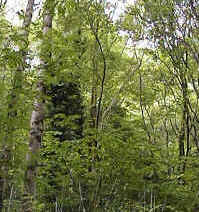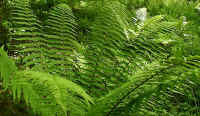Woodland Structure
Woodlands are composed of a variety of plants of differing heights. This gives a woodland a distinct vertical structure, similar to that of a multi-storey building.
 |
|
| The plants
growing beneath the dominant trees in a woodland can often be divided into a number of
distinct layers according to their height. These layers may include an understorey, or
shrub layer, of smaller trees which are adapted to grow under lower light conditions. In
addition, a field layer of grasses, ferns and wildflowers and a ground layer, largely
composed of mosses, may also be present. Depending on the amount of shade cast by the
dominant tree canopy, one or more of these layers may be discernible in a particular
woodland. The plant layers in a woodland will also influence the distribution of the
animals within the woodland. The number of layers which can be distinguished in woodlands is variable. In some woods, all four layers may be easily identifiable, whereas others may only have two. Some woodlands may even be composed of more than four layers. The number of layers present depends on a great many factors. These will include local climate and conditions, the species of plants present in the area (particularly the dominant trees), as well as the amount of light reaching the ground in individual areas. In woodlands where a lot of light reaches the woodland floor, all four layers may be well developed, whereas in densely shaded areas, little may be able to grow beneath the dominant tree canopy. In reality, the plant layers are not separate, but all intergrade. The distinctions between layers may be further blurred by plants such as Ivy and Honeysuckle which seek the light by climbing up through some of the layers, using other plants, such as the trees, as supports. Epiphytes (plants which grow on other plants, using them as a solid base), such as ferns, mosses and lichens, will also clothe the branches of older, more mature trees. As with the climbers, this enables them to gain better access to available light. The division of plants within a woodland into layers is essentially a human convenience, but it is nevertheless a useful descriptive tool to help identify differences in individual woodlands. . |
Canopy/Tree Layer |
||
 |
The tallest, most mature trees form the canopy of a woodland. The leaves of species such as Beech are so effectively patchworked and angled to catch the maximum amount of light, that they cast a very dense shade. This allows few plants to survive underneath. Ash, by contrast, with its finely divided leaves, allows more light through to the woodland floor, so that layers are more likely to develop. | Typical
Species |
Understorey/ Shrub Layer |
||
 |
This layer consists of younger individuals of the dominant trees, together with smaller trees and shrubs which are adapted to grow under lower light conditions. These characteristic understorey trees sometimes have a sprawling sideways growth form (e.g. Hazel). This enables them to increase the surface area available to trap light filtering through the upper canopy. Invasive, non-native species such as Rhododendron, may dominate this layer in some woods. |
|
Field Layer |
||
 |
The field layer is usually best developed where substantial amounts of light reach the woodland floor, for example in clearings, or newly coppiced areas of woodland. | Ferns |
Ground Layer |
||
 |
The ground layer will largely consist of a great variety of different mosses. It may also include ivy growing along the ground rather than climbing up in the trees. Mosses require constant high moisture levels, so this layer will be less well developed in drier woods. | Mosses |
The vertical structure of a woodland's plant life will also influence where different animals are likely to be found in a wood. For example, the large branches of trees in the canopy layer will provide nesting sites strong enough to support large birds such as Buzzards and Herons. The new spring leaf canopy of trees, particularly Oak, provide feasts for large numbers of caterpillars such as the Winter Moth and the Green Oak-roller Moth. In some years, the leaf canopy may be almost entirely stripped by plagues of caterpillars. Many small birds will take advantage of this seasonal bounty. A single Great Tit may eat up to 300 caterpillars a day! Beneath the canopy layer, a well developed understorey or shrub layer will provide numerous nesting and food opportunities for smaller woodland birds. A field layer of herbs and grasses supplies food and microhabitats for a wide range of butterflies and other invertebrates. |